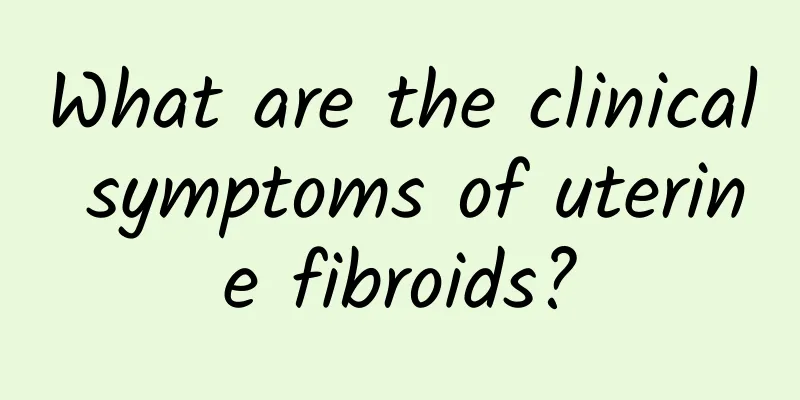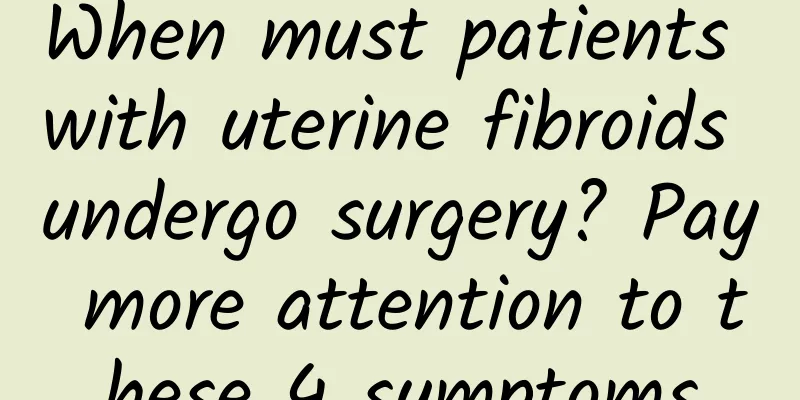What are the clinical symptoms of uterine fibroids?

|
The incidence of uterine fibroids is extremely high, which can easily cause infertility and other problems. Early detection and treatment of uterine fibroids can reduce the harm caused by uterine fibroids. So what are the clinical symptoms of uterine fibroids? Experts will introduce them. What are the clinical symptoms of uterine fibroids? Uterine fibroids usually have no obvious symptoms and are only occasionally discovered during pelvic examinations. The onset of uterine fibroid symptoms is closely related to the location, growth rate, and degeneration of the fibroids, but has little to do with the size or number of the fibroids. 1. What are the clinical symptoms of uterine fibroids? Menstrual changes: the most common symptom. Large intramural fibroids increase the area of the uterine cavity and endometrium, resulting in poor uterine contractions or excessive endometrial hyperplasia, which can lead to shortened menstrual cycles, increased menstrual volume, prolonged menstrual periods, irregular vaginal bleeding, etc. Submucosal fibroids often cause menorrhagia, and as the fibroids grow larger, the menstrual period is prolonged. Subserosal fibroids and small intramural fibroids often have no obvious menstrual changes. 2. Increased leucorrhea: Intramural fibroids increase the area of the uterine cavity, increase the secretion of endometrial glands, and are accompanied by pelvic congestion, resulting in increased leucorrhea. Submucosal fibroids suspended in the vagina are susceptible to infection and necrosis on their surface, producing a large amount of purulent and bloody discharge and necrotic tissue discharge, accompanied by a foul odor. 3. What are the clinical symptoms of uterine fibroids? Compression symptoms: Fibroids compress the bladder and cause frequent urination, urination disorders, and urine retention. 4. Abdominal mass: Patients often complain of abdominal distension and a mass felt in the middle of the lower abdomen. The mass is hard and irregular in shape. 5. Abdominal pain, backache, and lower abdominal distension: Patients usually have no abdominal pain, but acute abdominal pain occurs when the pedicle of the subserosal fibroid is twisted. When the fibroid turns red, the abdominal pain is severe and accompanied by fever. 6. Infertility: According to literature reports, it accounts for 25% to 40%. It may be that the fibroids compress the fallopian tubes and twist them, or deform the uterine cavity, hindering the implantation of the fertilized egg. |
<<: What's wrong with a small amount of menstrual flow and black color?
>>: What does uterine fibroids mean?
Recommend
Can patients with pelvic inflammatory disease get pregnant?
Can you get pregnant with pelvic inflammatory dis...
Treatment of rheumatic arthralgia after abortion
Artificial abortion is very harmful to women. Som...
Will menstruation become irregular during menopause?
Menstruation during menopause may be irregular, b...
Don’t stop exercising just because you’re tired! To protect your health, you must live and move throughout your life
Some people deliberately avoid using escalators o...
What are the dangers of congenital absence of vagina?
What is female vaginal amenorrhea? What are the h...
Experts will help you understand the pathological causes of vulvar atrophy
Many patients with vulvar leukoplakia will find d...
Diet therapy can help you solve the pain of dysmenorrhea
"Abdominal pain during menstruation" is...
Double the fat burning effect! Shoulder binding + simple stretching
After tying the elastic band on your shoulders an...
Three aspects of care are essential for patients with uterine fibroids after hysterectomy
Uterine fibroids are benign gynecological tumors ...
Stop before, during and after strenuous exercise! The hidden dangers of energy drinks
If you like to drink a can of energy drink to boo...
What is the difference between ectopic pregnancy and biochemical pregnancy
What is the difference between an ectopic pregnan...
What causes endometrial polyps?
The cause of endometrial polyps is considered to ...
The dangers of vaginal candidiasis
The dangers of vaginal candidiasis The main harm ...
Middle-aged men are troubled by their barrel waists. Lazy people are losing weight and it is becoming popular.
Many middle-aged office men, who are under 40 yea...
Victoria's Secret Angel supermodels reveal their secrets to good figure
Can you imagine that your first fashion show in y...









